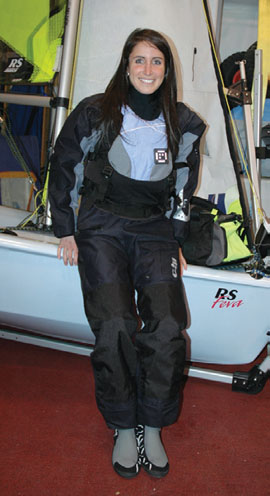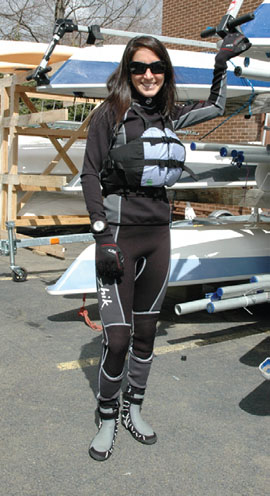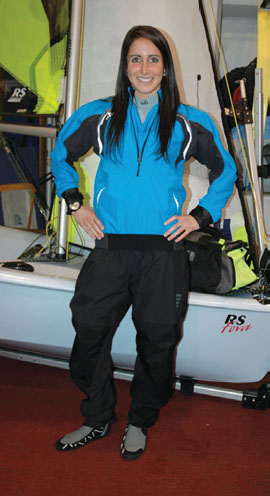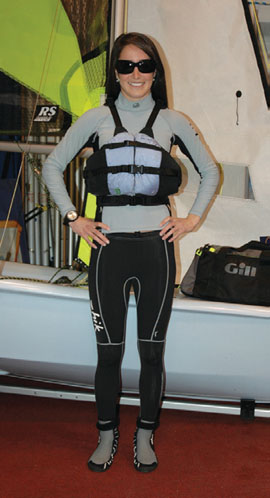by Rob Simmons
The spring sailing season is right around the corner, so it’s time to go up to the attic and see what we have in the ol’ sailing bag. Many people have been looking at all of those giant snow piles as timetables. As they got smaller, the sailing season got closer. That melting snow is half the reason sailors must dress appropriately during the first season of the year. Water has a high thermal inertia, which means it will retain its temperature for a lengthy period of time. Here in the Northeast, the water will not start to feel warm until late June. Fortunately, with the advances in clothing fabric technology, sailing apparel companies have been able to develop gear for sailors to comfortably go out in practically any weather conditions.
Frostbiting, high school and collegiate teams all start around the beginning of March, assuming their local body of water is sailable. At that time of the year – and indeed through April – the water in this area is frigid, and sailors must be very careful to avoid hypothermia. On the competitive side, one must find the median between being too hot and too cold, because extremes on both sides of the spectrum will negatively affect your performance on the racecourse.
The appropriate attire for cold water sailing can be broken down in three categories: base layer, mid layer and outer layer. The base layer will be in direct contact with your skin, so it’s imperative that it’s a breathable or moisture-wicking material. The mid layer will primarily provide the warmth, and the outer layer will keep everything underneath dry.
Breathable fabrics allow water vapor to pass through. A breathable base layer will take the sweat from your body and pass it through to the mid layer. A cotton base layer (such as a T-shirt) should be avoided, because it will absorb perspiration and consequently draw heat from your body. I’ve found polyester or a thin fleece to be the most effective base layers. Try to find a base layer that will work as well under a drysuit as it will under spray gear (or by itself when warmer weather arrives).
Fleece jackets and wool sweaters are great insulators for your mid layer. Fleece has its advantages, as it can be simply thrown in the wash after a long day of sailing. Again, no cotton! If you wear a cotton sweatshirt it will act like a dam, blocking perspiration from escaping to the next layer. I’ve found quarter-zip fleeces to be the most effective in the mid layer. Try to stay away from full zip garments, as they tend to inhibit your movement in small confined areas such as the spaces in small dinghies.

Outer Layer – Cold weather sailing: from bottom to top, Zhik 460 Boot, Gill Stretch Drysuit socks, Astral Bella PFD, Gill Dry-suit

Outer Layer – Form fitting neoprene, Zhik 460 Boot, Zhik Microfleece Pants, Gill Three Seasons Gloves, Ronstan Sailing Watch, Zhik Titanium Top, Astral Otter PFD, Kaenon “Georgia” Polarized Sunglasses

Outer Layer – Spray Gear / Late Spring Early Summer: from bottom to top, Zhik 460 Boot, Gill Pro Salopettes (Zhik Hydrophobic Pants under spray pants), Ronstan Sailing Watch, Gill Pro Top (Spray Top), Zhik Hydrophobic Fleece Top
One set of base and outer layers will be sufficient throughout most of the spring season, although you should adjust the weight and thickness of your mid layer depending on the weather conditions. A general rule of thumb of mine was the greater the probability that I’d be going for an inadvertent swim because of a capsize, the warmer I’d dress. Always be careful, however, not to overdress. Sweating can be far more dangerous than under dressing. Water ex tracts heat from your body much faster than air, which ultimately can lead to hypothermia.
The drysuit is the most efficient outer layer for cold weather dinghy sailing. All northern schools and many frostbiting leagues require sailors to wear drysuits for safety. There are many drysuits on the sailing gear market. The zipper on the drysuit is very important, so it’s no surprise that it’s also the most expensive raw material of the suit, which can drive the cost quite high. If you’re buying a cheaper drysuit, most likely you’re buying a cheaper zipper. Brass zippers are optimal, and the cheaper plastic zippers are not as reliable.
Some companies have stopped even offering a cheaper zipper because they were coming apart and not forming an adequate seal. A dry suit with a hole in any section is counterproductive! The front zipper is very convenient and user-friendly. The back zip requires help from a friend or teammate, while the front zip can be opened and closed by the sailor. This function will undoubtedly come in handy when a sailor over-hydrates as they should. In my opinion, the greatest advancement in dinghy drysuits is neoprene neck and wrist seals. The older latex seals are uncomfortable and have an awful smell of rubber. The waterproof neoprene seals are soft, and they prevent water from coming in without restricting blood circulation at your wrists and neck.
The downside to the waterproof neoprene seals is that they’re much thicker. Therefore, most drysuit booties are still made of latex. The rubber does not provide any thermal insulation, so make sure to wear socks of the same material as you would wear in your mid layer. Again, be extra careful not to wear too thick a sock. The rubber booties are not breathable, so if your feet start sweating the moisture will be trapped down in your boots and your feet will freeze.

Base Layer: from bottom to top, Zhik 460 Boot, Zhik Hydrophobic Fleece Pants, Zhik Hydrophobic Fleece Top, Ronstan Sailing Watch, Astral PFD, Kaenon “Georgia” Polarized Sunglasses
![[Outer Layer - Spray Gear / Late Spring Early Summer: from bottom to top, Zhik 460 Boot, Gill Pro Salopettes (Zhik Hydrophobic Pants under spray pants), Ronstan Sailing Watch, Gill Pro Top (Spray Top), Zhik Hydrophobic Fleece Top] [Outer Layer - Spray Gear / Late Spring Early Summer: from bottom to top, Zhik 460 Boot, Gill Pro Salopettes (Zhik Hydrophobic Pants under spray pants), Ronstan Sailing Watch, Gill Pro Top (Spray Top), Zhik Hydrophobic Fleece Top]](https://windcheckmagazine.com/app/uploads/2019/02/45-gearup-5.jpg)
[Outer Layer – Spray Gear / Late Spring Early Summer: from bottom to top, Zhik 460 Boot, Gill Pro Salopettes (Zhik Hydrophobic Pants under spray pants), Ronstan Sailing Watch, Gill Pro Top (Spray Top), Zhik Hydrophobic Fleece Top]
Gloves are the hardest article of sailing gear to suggest to another dinghy sailor. You need thickness for warmth, but at the same time you need a thin glove to allow you to pinch, primarily for tying and untying knots. I have found dishwashing gloves to work quite well, with a liner underneath and a summer fingerless glove on top.
My recommendation for the base layer is Zhik’s Hydrophobic Spandex Fleece top and bottom. Both of these pieces are tight and form fitting, and they’re great for use under a drysuit or spray gear, or simply by themselves. For the mid layer, if I had to choose one piece not knowing what the day’s weather conditions are going to be, I would buy the Grid Microfleece Zip Neck from Gill. This is nice lightweight fleece with raised waffle texture with a quarter zip.
In the earlier spring, look at the Gill Pro Drysuit (front zip). As summer gets closer, I recommend the Gill Pro Top and Salopettes (spray top and pants) for C420 sailors. Laser sailors prefer more of a form-fitting outer layer, and I suggest the Zhik Titanium Top. These thin neoprene tops and bottoms are what all of the top sailors in the world are wearing. Zhik has even developed a thick neoprene for cold weather sailing called the Superwarm series. This heavily insulated neoprene can replace a drysuit, even in extreme conditions. Any wool or fleece sock will be efficient under a drysuit, but in late spring if you need a warm sock to wear under hiking boot try the Zhik Superwarm Sock. If my earlier recommendation for gloves was not sufficient, try Gill’s Neoprene Winter Gloves for superior insulation.
Top everything off with a warm hat and a pair of polarized sunglasses and you’ll be ready to get on the racecourse. If this is your first year sailing in cool weather, make sure the only piece of cotton in your gear bag is a towel. If you keep your body core warm, your extremities will stay warm. When your body starts to get cold it slows your thinking process down and your performance on the racecourse will diminish. Stay warm and you’ll stay competitive.
Rob “Coach Bobbo” Simmons grew up sailing Optis in Long Island Sound. He was a member of the US National Optimist Team and the Eckerd College Sailing Team in St. Petersburg, FL. He has coached race teams in Optis, Lasers, and C420s and been a high school sailing coach. He works at The Boat Locker in Westport, CT.




